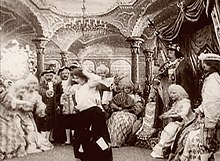Cinderella (1899 film)
| Cinderella | |
|---|---|
 A scene from the film | |
| Directed by | Georges Méliès |
| Based on | Cinderella by Charles Perrault |
| Produced by | Georges Méliès |
| Starring |
|
Release dates |
|
Running time | 6 minutes |
| Country | France |
Cinderella (French: Cendrillon) is an 1899 French film directed by Georges Méliès, based on the fairy tale by Charles Perrault. It was released by Méliès's Star Film Company and is numbered 219–224 in its catalogues, where it is advertised as a grande féerie extraordinaire en 20 tableaux.[1]
Cast[]
The casts of Méliès's films are in many cases unidentified. Most of the following listing is based on cast identifications made by the film scholars Georges Sadoul, Jacques Malthête, and Laurent Mannoni.[1]
- Mlle Barral as Cinderella.[1] Barral had also acted in Méliès's bedroom farce The Bridegroom's Dilemma earlier that year.[2]
- Bleuette Bernon as the Fairy Godmother.[3] Méliès discovered Bernon in the 1890s, when she was performing as a singer at the cabaret L'Enfer. Her appearance in Cinderella is contemporaneous with her performances at the Eldorado cabaret. She also appeared as Phoebe, the woman on the crescent moon, in Méliès's famous A Trip to the Moon.[4]
- Carmelli as the Prince.[3] Carmelli was an actor at Méliès's theater of stage illusions, the Théâtre Robert-Houdin in Paris.[5]
- Jehanne d'Alcy as the Prince's mother, the Queen.[1] D'Alcy had achieved success in theatrical productions by 1896, but left the stage to devote herself to film, becoming one of the first performers to do so. She appeared in many of Méliès's films and later became his second wife.[4]
- Dupeyron as a party guest.[1]
- Georges Méliès as the genie of the midnight clock, and as a halberdier.[1] All told, Méliès took an acting role in at least 300 of his 520 films.[6]
Production[]

Méliès modeled the film's visual style on the engravings of Gustave Doré, who had illustrated the story for an edition of Perrault's fairy tales. (Doré was stylistically influential across Méliès's career, especially in this film and in his film adaptations of four other works Doré had illustrated: Red Riding Hood, Blue Beard, The Wandering Jew, and Baron Munchausen's Dream.)[7] The direct inspiration for the film of Cinderella was probably a stage adaptation premiered in 1896 by the Théâtre de la Galerie-Vivienne and played by the Troupe Raymond at Méliès's own theatre of illusions, the Théatre Robert-Houdin, at Christmastime of 1897.[8] Méliès may also have been inspired by the Théâtre du Châtelet's lavish 1895 stage production of the story.[9]
Cinderella was Méliès's first film with multiple scenes (tableaux), using six distinct sets and five changes of scene within the film. (His catalogue, by dividing the action into smaller beats, lists twenty tableaux within the film, a generous numbering probably devised for publicity reasons.)[1] So many extras were used in Cinderella that Méliès designated a Chief Extra to lead them.[4] The film's special effects were created with multiple exposures, dissolves, and substitution splices.[10]
Reception[]
Cinderella was Méliès's first major cinematic success.[11] It did well both in French fairground cinemas and at European and American music-halls, and inspired Méliès to create other lavishly designed storytelling films with multiple scenes.[8] His next film with multiple scenes, Joan of Arc (1900), was his first to surpass 200 meters of film in length, and was also a marked success.[11] According to the film historian Lewis Jacobs, Cinderella's use of spectacle on screen also influenced the films of Cecil B. DeMille.[8]
Méliès made another adaptation of the story, Cinderella or the Glass Slipper, in 1912 under the supervision of Pathé Frères. This version was not a success, partially because of directorial conflict between Méliès, Ferdinand Zecca, and Charles Pathé, and partially because Méliès's theatrical style had fallen out of fashion by 1912.[8]
References[]
- ^ a b c d e f g Malthête, Jacques; Mannoni, Laurent (2008). L'oeuvre de Georges Méliès. Paris: Éditions de La Martinière. pp. 101–102. ISBN 9782732437323.
- ^ Malthête & Mannoni, p. 94
- ^ a b Bertrand, Aude (2010), Georges Méliès et les professionnels de son temps (PDF), Université de Lyon, p. 117, retrieved 20 December 2014
- ^ a b c Wemaere, Séverine; Duval, Gilles (2011). La couleur retrouvée du Voyage dans la Lune. Groupama Gan Foundation for Cinema and Technicolor Foundation for Cinema Heritage. p. 165. Retrieved 10 August 2013.
- ^ Bertrand 2010, p. 48
- ^ Malthête & Mannoni, p. 88
- ^ Frazer, John (1979). Artificially Arranged Scenes: The Films of Georges Méliès. Boston: G. K. Hall & Co. p. 16. ISBN 0816183686.
- ^ a b c d Frazer, p. 220
- ^ Frazer, p. 7
- ^ Essai de reconstitution du catalogue français de la Star-Film; suivi d'une analyse catalographique des films de Georges Méliès recensés en France. Bois d'Arcy: Service des archives du film du Centre national de la cinématographie. 1981. p. 83. ISBN 2903053073. OCLC 10506429.
- ^ a b Malthête & Mannoni, p. 106
External links[]
- Cinderella at IMDb
- Cinderella is available for free download at the Internet Archive
- 1899 films
- French films
- French silent short films
- French drama films
- French black-and-white films
- Films directed by Georges Méliès
- Films based on Charles Perrault's Cinderella
- 1890s drama films
- 1890s short films
